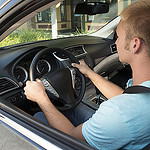A few weeks ago I posted on the subject of technology and phone apps that monitor teen driver conduct and disable texting. In general, I offered my opinion that GPS-like technology that monitors a teen’s driving, such as location, speed, and key driving habits such as acceleration and braking are worthwhile, and if affordable are a good tool for parents. I also repeated my concern about apps that purport to disable texting and cell phone use, arguing in favor of a stricter method — teen drivers putting their cell phone in the glove box before the ignition goes on, and leaving it there until the car is turned off.
In putting up this post I neglected to discuss a third type of system, which is teen driver controls that are installed as a unified system by the manufacturer. At the recent Governors Highway Safety Association annual meeting, representatives of Ford were on hand to describe the current state of their “My Key” system.
Note: It is my policy on this blog to not endorse products or companies, and this post is not an endorsement of any manufacturer or system. I am just reporting here what I learned at GHSA on the generic subject of in-vehicle systems. In particular, I have not seen the Ford system demonstrated in practice, so I cannot comment on how user-friendly or reliable it is, and whether it presents its own set of distractions.
Anyway, the My Key system was described as currently having the following features to warn and regulate teen drivers:
· Speed chimes when the car reaches 45, 55, and 65 MPH;
· A maximum speed governor, which can be set at the vicinity of 70 MPH;
· Blocking of all incoming cell phone calls and text messages, and disabling of sending text messages;
· A system feature that prevents the driver from disabling the system;
· Allowance at all times of emergency 911 calls;
· An entertainment system that cannot be turned on until the driver’s seat belt has been clicked; and
· Maximum volume on the sound system.
My Key is now available on all North American models.
 Again, putting aside how this system functions and its dependability, I have to say that I am impressed with this combination of features, because except for passengers and alcohol (wouldn’t it be great if we added an alcohol detection/ignition interlock for all teen drivers?), the system targets primary dangers of teen driving – seat belt use, speed, and distraction from sound system volume.
Again, putting aside how this system functions and its dependability, I have to say that I am impressed with this combination of features, because except for passengers and alcohol (wouldn’t it be great if we added an alcohol detection/ignition interlock for all teen drivers?), the system targets primary dangers of teen driving – seat belt use, speed, and distraction from sound system volume.
One issue, of course, is that these features are offered on new models only. It will take many years before this technology package is available on the used car market, which of course is where many teens get a first, more affordable vehicle.
I will be looking into what other manufacturers are offering, but for this moment I will observe that the availability of this package of features to control teen driving is a positive step.
Photo by State Farm 

